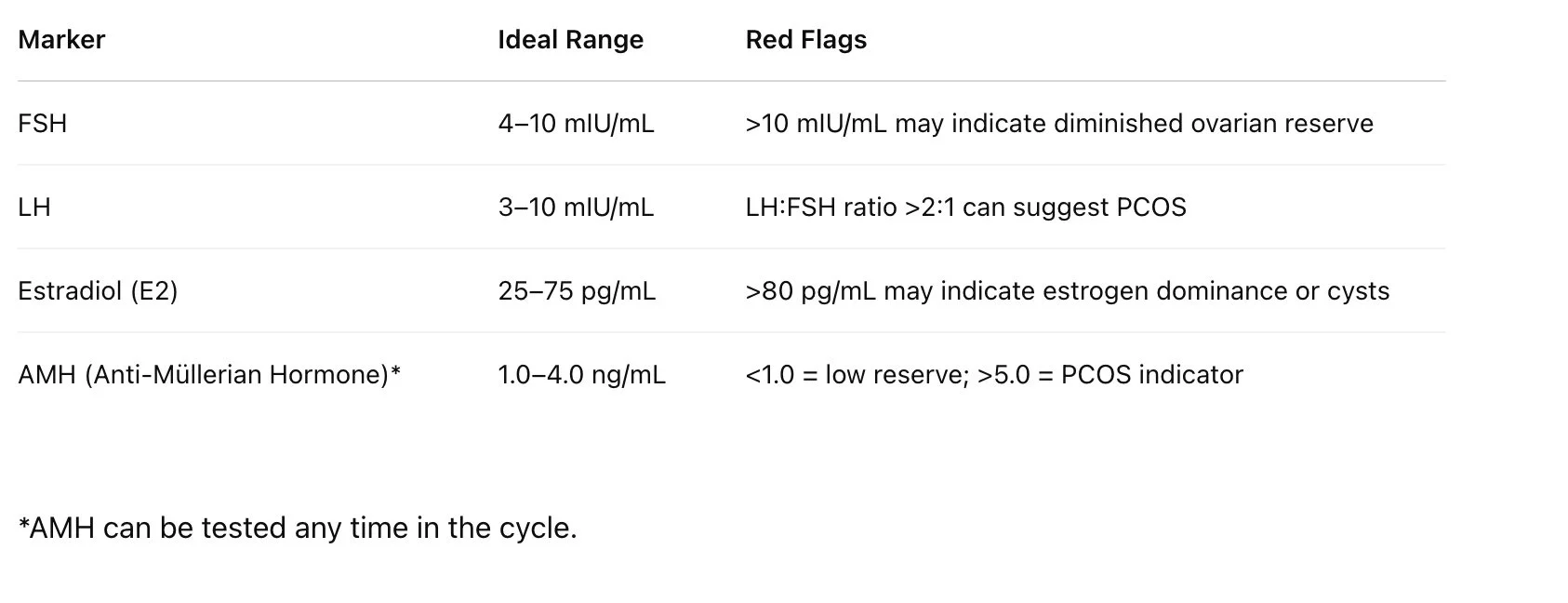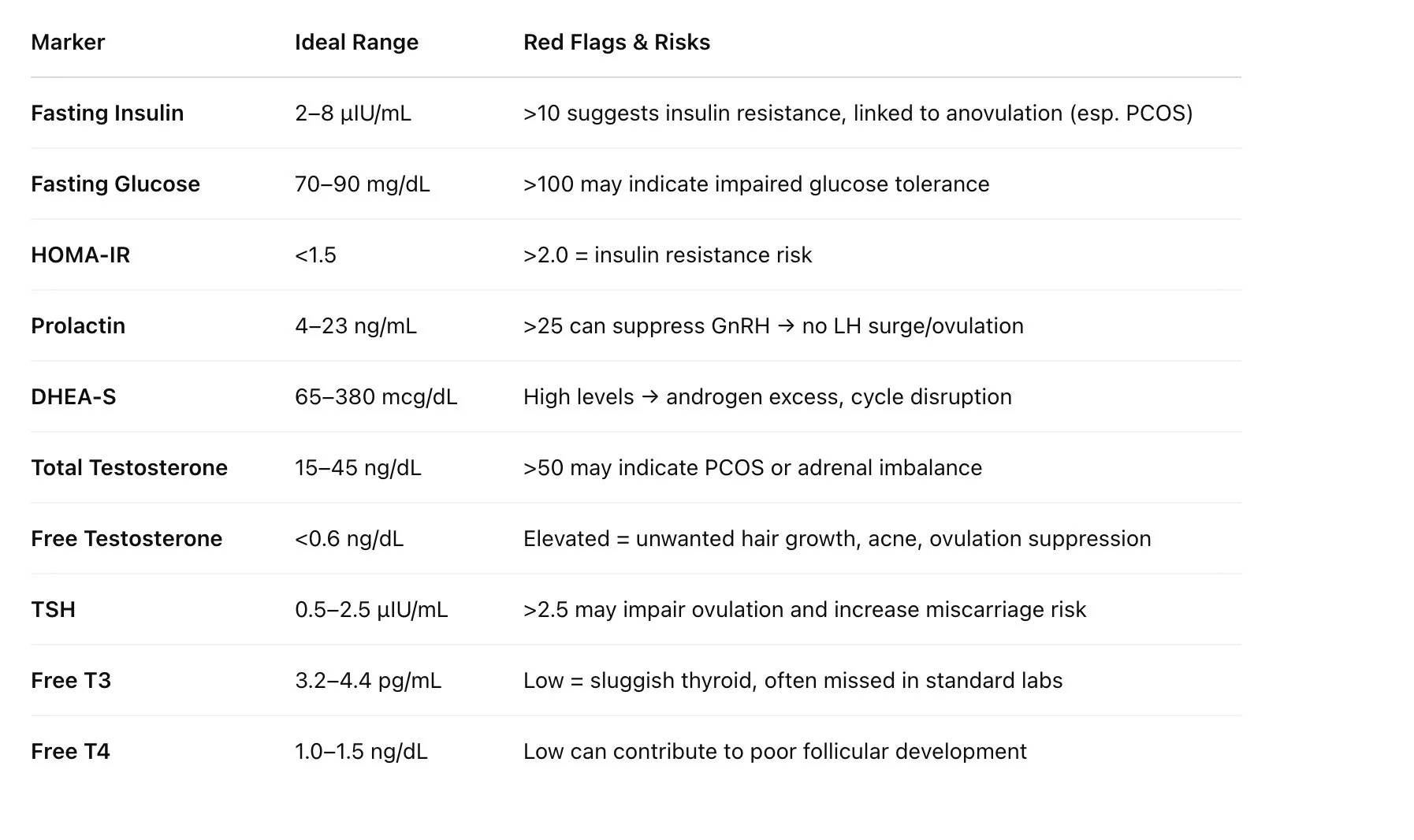Your Cycle’s Power Move: Ovulation Uncovered
Mascari, Brooke - April 20, 2025
Ovulation: The True Indicator of Women’s Health
When we think about the menstrual cycle, most of us picture the bleeding phase—what’s commonly referred to as a “period.” But in reality, ovulation is the main event. While menstruation marks the shedding of the uterine lining, ovulation reflects the overall hormonal health of a woman’s body. It is the most critical phase, not just for fertility but for overall well-being.
Why Ovulation Matters
Ovulation is the process by which a mature egg is released from the ovary. It typically occurs midway through the menstrual cycle and triggers a series of hormonal events that influence everything from metabolism and bone health to mood and cardiovascular function.
Hormones involved in ovulation include:
Follicle Stimulating Hormone (FSH): Stimulates the growth of ovarian follicles.
Luteinizing Hormone (LH): Triggers the release of the egg.
Estrogen: Peaks before ovulation to prepare the uterine lining.
Progesterone: Rises after ovulation to support potential implantation and pregnancy.
These hormones work in a delicate balance. Ovulation is the body’s way of showing that this hormonal orchestra is playing in harmony.
Ovulation as a Vital Sign
The American College of Obstetricians and Gynecologists (ACOG) considers the menstrual cycle a fifth vital sign, and ovulation is at its core. A regular ovulatory cycle tells us:
The hypothalamic-pituitary-ovarian axis (HPO axis) is functioning properly.
Estrogen and progesterone are in balance.
The body has adequate energy and nutrients.
Stress and inflammation are well-managed.
The woman is not under chronic physical or emotional strain.
In other words, ovulation reflects whole-body health.
Anovulation: When the Egg Doesn't Drop
Anovulation refers to the absence of ovulation. A woman can still bleed monthly without ovulating; this is called anovulatory bleeding. It often results from unopposed estrogen, meaning estrogen builds up the uterine lining, but without the balance of progesterone (which only rises after ovulation), the lining eventually sheds irregularly.
Common Causes of Anovulation:
Chronic stress
Excessive exercise
Eating disorders or insufficient caloric intake
Polycystic ovary syndrome (PCOS)
Thyroid dysfunction
Perimenopause
Elevated prolactin
Certain medications
Why Ovulation Is Essential: Even Outside of Fertility
Even for women who aren't trying to conceive, ovulation supports long-term health:
Bone Density: Progesterone (produced after ovulation) plays a role in building bone. Women who don't ovulate regularly (e.g., those with hypothalamic amenorrhea or PCOS) have an increased risk of osteoporosis.
Heart Health: Estrogen and progesterone support vascular health and reduce inflammation.
Mood and Brain Function: These hormones influence neurotransmitter levels (like serotonin and dopamine), cognitive function, and emotional regulation.
Thyroid Health: Estrogen and progesterone impact thyroid hormone conversion and sensitivity. Low progesterone (from lack of ovulation) can contribute to hypothyroid symptoms.
Breast and Endometrial Protection: Progesterone helps modulate estrogen’s proliferative effects on breast and uterine tissue, reducing cancer risk.
Can You Have a Period Without Ovulating?
Yes. As noted, anovulatory cycles can still cause bleeding. However, the bleeding is often irregular, heavier or lighter than normal, and may occur unpredictably. It is not a true period but rather a withdrawal bleed caused by fluctuating or declining estrogen levels.
Natural Birth Control Without Hormones: Can It Be Done?
Yes, but it requires understanding and tracking ovulation. Fertility Awareness Methods (FAM) involve tracking signs such as:
Basal Body Temperature (BBT): A rise in temperature indicates that ovulation has occurred.
Cervical Mucus Changes: Stretchy, egg-white mucus signals high fertility.
Cervical Position: Becomes high, soft, and open during fertile days.
LH testing: Urine strips can detect the LH surge, which precedes ovulation by ~24–36 hours.
The fertile window is only about 5 days per cycle, with the day of ovulation and the 2 days before it being the most fertile. Abstaining or using barrier methods during this time can prevent pregnancy naturally.
However, this method is only effective if cycles are regular and signs are tracked diligently!
How to Support Monthly Ovulation
If you’re not ovulating regularly, don’t panic; it’s common and often reversible with lifestyle and functional support.
Promoting Healthy Ovulation:
Eat Enough Nutrient-Dense Food
Undereating or extreme dieting suppresses ovulation.
Focus on proteins, healthy fats, complex carbs, and essential micronutrients (like zinc, B6, magnesium, and iodine).
Balance Blood Sugar
High insulin levels (as seen in PCOS) can disrupt ovulation.
Eat balanced meals and avoid high-glycemic foods.
Manage Stress
Chronic cortisol elevation suppresses GnRH, FSH, and LH.
Incorporate calming practices: meditation, breathwork, walking, yoga.
Support Thyroid Health
Get tested (TSH, Free T3, Free T4, antibodies).
Ensure adequate selenium, iodine, and iron.
Sleep 8–10 Hours Per Night
Melatonin supports ovarian function and hormone regulation.
Avoid Endocrine Disruptors
Ditch plastics, toxic cleaning products, and synthetic fragrances.
Consider Herbal and Nutraceutical Support
Vitex (chasteberry), magnesium, B-complex, and omega-3s can support hormonal harmony (under guidance and with consistency).
Address Underlying Conditions
PCOS, hypothyroidism, high prolactin, etc., may need targeted interventions.
Ovulation as a Monthly Hormone Report Card
Ovulation is more than the release of an egg, it's a sign that the body is in hormonal harmony. It tells us:
The hypothalamus, pituitary, and ovaries are communicating properly (via the HPO axis).
The body is adequately nourished and not under excessive stress.
The hormones estrogen and progesterone are cycling in balance.
Without ovulation, progesterone is not produced in sufficient amounts, leading to estrogen dominance, mood disorders, irregular cycles, inflammation, and more.
Key Hormonal Players and What They Tell Us
Estrogen (Estradiol, E2): Builds the uterine lining, peaks pre-ovulation.
Luteinizing Hormone (LH): Spikes to trigger ovulation.
Follicle-Stimulating Hormone (FSH): Supports follicle maturation.
Progesterone: Rises post-ovulation, supports the luteal phase.
Testosterone and Androgens: Needed in balance; elevated levels can disrupt ovulation (e.g., in PCOS).
Insulin and Glucose: Regulate ovarian sensitivity to LH and androgen production.
Prolactin: Can suppress ovulation if elevated.
Thyroid Hormones (TSH, Free T3, Free T4): Affect all stages of the menstrual cycle.
Lab Work to Assess Ovulation and Hormonal Balance 🩸
Clinicians often use cycle-specific bloodwork to evaluate ovulation and cycle health. Below is a breakdown of relevant panels, when to test, ideal ranges, and red flags to watch for.
Cycle Day Specific Hormones:
Cycle Days 2–4:
Baseline Hormone Assessment
Mid-Cycle (Around Day 12–14):
Ovulatory Surge Check
7 Days After Ovulation (Usually Day 19–23):
Progesterone Peak
Metabolic and Other Hormone Panels 🧪
Any Time of Cycle (Fasting Recommended for Metabolic Markers)
Consequences of Not Ovulating
When ovulation doesn’t occur regularly:
No progesterone is produced ➝ estrogen dominance, mood instability, PMS, breast tenderness, and heavy periods.
Cyclical inflammation continues unchecked ➝ higher risk of endometriosis, fibroids, and hormonal migraines.
Nutrient depletion occurs ➝ Progesterone helps regulate zinc, copper, and B vitamins.
Long-term risks rise ➝ including osteoporosis, heart disease, infertility, and metabolic disorders.
Supporting Monthly Ovulation Naturally
You can’t force ovulation, but you can create the conditions in which it thrives:
Eat enough (especially healthy fats and protein): Ovulation requires a minimum caloric and fat threshold.
Balance blood sugar: Insulin resistance directly impacts ovarian function.
Sleep consistently: Deep sleep supports GnRH pulsatility and LH production.
Track your cycle: Use basal body temperature, cervical mucus, and LH strips to confirm ovulation.
Manage stress: Chronic cortisol elevation can shut down ovulation.
Limit alcohol and xenoestrogens: These disrupt the liver’s ability to metabolize hormones properly.
Final Thoughts💡
Ovulation isn’t just an optional thing; it’s essential for long-term hormonal health, whether or not a woman desires pregnancy. Regular ovulation is a marker of wellness, driven by internal balance and external lifestyle factors.
The beauty of the female body is that it leaves clues, and ovulation is one of the most powerful signs that all systems are a "go" (ie, all systems are in balance, healthy, happy, and aligned). By understanding your bloodwork markers, tuning in to your cycle, tracking your rhythms, bringing awareness to your unique self, and supporting your body with intention, you can work with your biology, not against it!
Ovulation is like a monthly report card for your hormonal, metabolic, and reproductive health. Regular, healthy ovulation means the body is nourished, safe, and functioning optimally. If you're not ovulating, it's your body’s way of signaling that something needs attention.
Rather than focusing solely on the period as the hallmark of womanhood, it’s time to celebrate ovulation as the true center of the female cycle, the vital pulse that supports not only fertility but every system of a woman’s body.
Love and blessings on your journey! And as always, don’t hesitate to reach out for further support.




